For more information:
Note that the latest stuff may not yet be indexed.
The Klezmer Shack directory of articles
A diversity of klezmer and Jewish music
Klezmic noiZ / Davka, 2001
Second Avenue Klezmer / For our mothers, 1998
Roberto Rodriguez / El danzon de Moises, 2002
Moshe Berlin / Maz'l Tov, 2002
Marilyn Lerner and David Wall / Still soft-voiced heart, 2001
London, Sklamberg, Schwimmer / The Zmiros Project, 2002
Orchestre Andalou D'Israel / Jerusalem
Kol Oud Tof Trio / Gazelle, 2002
Seth Austen / Desert Winds, 1996
The Kabalas / Time Tunnel, 1999
The diversity continues. Even the klezmer albums reviewed this week aren't necessarily so traditional. On the other hand, I am delighted to present some very traditional (and not entirely so) Mizrahi sounds to readers' attention.
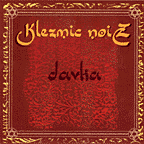 Klezmic noiZ / Davka.
Klezmic noiZ / Davka.
This Dutch band aggressively stakes out ground as a band that starts from klezmer, but adds in many other influences. By the time one listens to their rendition of "Der Yid," originally a Naftule Brandwein tune, now set, in part, to the Bo Diddley beat and jazz improvisation, this is abundantly clear. The same sort of syncopation drives "Hassidic Dance" until the beat picks up and the rhythm degenerates to the usual bar mitzvah thump thump (unusual and disappointing here). The band sometimes alternates moods quickly within a piece. Sometimes this works. Sometimes, as on "Dzhankoye," the result feels more manic/depressive than cohesive. Vocalist Patricia Beysens has a slightly smokey, soulful voice that goes well with the material (when the band slows down enough to allow her to do her thing, as on "Di Sapozkhelekh" or "Sprayz ich more"). There are also some nifty little odd notes, like the Christmas carol motif with which the lullaby, "Amol iz geven a mayse" ends. The band also shows its jazz roots, as on "Knee Patch," which is much more a lovely jazz tune for the first couple of minutes, before migrating on to klezmer, then ending up an amalgam of Epstein Brothers 2nd avenue and rock 'n' roll, or on the "Heyser Bulgar" which slips into straight jazz and then back out. In between these, there are several, relatively traditional klezmer numbers, played in a combination of straight-forward klezmer, to jazz-rock-klezmer styles. All in all, this is quite an interesting, and often very good romp through traditional yiddish folksong and klezmer, one that sounds traditional rather more than one might expect.
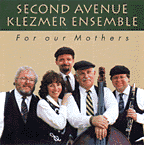 Second Avenue Klezmer / For our mothers.
Second Avenue Klezmer / For our mothers.
For CD purchases, e-mail Second Avenue Klezmer
Opening with the Yiddish film special, "Oy mame, bin ikh farlibt," restrained just a bit too much by percussion that is just a bit too much out front (a not atypical American Jewish wedding band fault), and with vocals pitched just a bit more shrill than comfortable, this is nonetheless an admirable and enjoyable album. The recording documents the range of traditional music that American Jews listen to today, from the worlds of Yiddish film and New York's Second Avenue Yiddish Theatre, to straightforward klezmer, to Ashkenazic and Sephardic folk songs (including an excellent, is drawn out, "Los bilbilicos", and a delightful ""La Comida La Mañana"). Similar Sephardic themes are used in "Hora," by band guitarist Jirji Svoboda, although here they are filtered through music played by Rom (Gypsy) musicians in Romania from the turn of the 20th century. The "Broyges Tantz" includes a lovely, jazzy slow bass solo. The musicians have the right spirit, and good ability. This is a good album, and a good introduction to some of the breadth of music American klezmorim play at Jewish Simchas these days. We're far beyond instrumental music, only (and many would say, "always have been, except in the world of 78rpm platters").
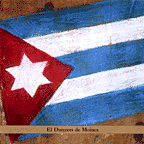 Roberto Rodriguez / El danzon de Moises, 2002. Tzadik TZ 7158, www.tzadik.com
Roberto Rodriguez / El danzon de Moises, 2002. Tzadik TZ 7158, www.tzadik.com
This is a good year to consider the Jewish-Latin fusion of musics. First, Hip Hop Hoodíos stole my hip hop heart. Then there was a recent Klezmer en Buenos Aires album, Shtil, to keep me happy. Now Roberto Rodriguez, most recently of Marc Ribot's Los Cubanose Postizos brings a panoply of Cuban rhythms together with an equally diverse set of Jewish melodies, and something very special takes place. From the opening marimba beat of "El Polaco," to the tango-ish "Danzonette Hebreo", with David Krakauer's lovely klezmer clarinet singing in and out, the album is a delight. What makes the album special is the humor and infectious joy of rhythm and music, both Cuban and Jewish. The two are fused into something so new that the ear is often tricked. "Aha," I think, in the middle of The Shvitz. "It's Cuban. But wait, that violin is entirely Jewish!" "Comparsa en altamar" is very Cuban piano--think Ruben Gonzalez, for instance, but also more. The strident opening of "Shalom Shango" speaks to not only Cuban and Jewish roots, but to the New York avant garde scene. For those of us still fixated on the rhythms and melodies of Eastern Europe, this album, like my favorite Anthony Coleman work, reminds us that there are other Jewish worlds, and other ways to seek out and unite the sparks that bring, if not tikun olam, certainly a tikun muzicali. Indeed, even the closing track, "Jerusalem Market" with the opening voice from a Mahane Yehuda vendor calling out for customers, to the traditional Israeli hora lines wrapped inside a solidly latin percussion, speaks to a Jewish flavored multicultural diversity that defines the best in music from not just the Jewish edges, but from deep within. This is exciting music. For another take on the album, the excellent Josh Kun's review, from the Boston Phoenix, titled, Shango Shalom, is also online.
 Moshe Berlin / Maz'l Tov, 2002. Available from CDBaby.com
Moshe Berlin / Maz'l Tov, 2002. Available from CDBaby.com
I have long believed that one should never dress up the blues in a tuxedo. The sweetness of this album belies that claim, as Mousa Berlin takes a wedding suite of tunes from a variety of sources, hasidic, other Israeli traditions, and contemporary, and sets them in a carefully-crafted, exquisite jewel of an album. From the opening track, to joyously sweet numbers such as "The Four Gates," Berlin's intent here is clearly not simply to present another klezmer album. Instead, in the liner notes, he writes about how the wedding, itself, is a time of both reality and mysticism, a time when G-d is said to grant special favor to His creations. These are, as the album title suggests, nigunim for the beginning of the journey that two people just married now undertake. Don't worry, however. It isn't as though Berlin doesn't let go, as on the title track or "Medley of Joyous Nigunim", and show why he is regarded as Israel's premier klezmer clarinetist. To confirm that reputation, the album concludes with some stunning live tracks.
On an album such as this, Berlin is also presenting the klezmer's music in a broader context--something that the "old-timey klezmer" bands, such as Budowitz and Khevrisa have also done on recent releases. While the results in those cases were beautiful, here the traditions that younger klezmorim have painstakingly researched and rediscovered, are presented in modern, still beautiful, still deep settings by Berlin who grew up with, and who has been carrying the tradition on for a generation. Indeed, in an interview this summer Berlin talked about how, in a way, he and Zev Feldman were similar, just playing with time in different ways: Feldman was starting with current klezmer traditions and rediscovering the past; Berlin was taking the traditions he learned and discovering how they need to evolve into the present.
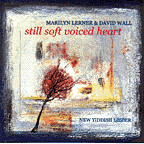 Marilyn Lerner and David Wall / Still soft-voiced heart, 2001. Traditional Crossroads, 80702-4310-2, www.traditionalcrossroads.com
Marilyn Lerner and David Wall / Still soft-voiced heart, 2001. Traditional Crossroads, 80702-4310-2, www.traditionalcrossroads.com
David Wall is one of the amazing voices in Jewish music today. Along with Lorin Sklamberg and Michael Alpert, he manages to make songs come expressively alive. This album, with pianist and fellow Flying Bulgar Marilyn Lerner is, in some ways, a continuation of work they did with a somewhat larger, more jazzy ensemble several years ago, From Both Ends of the Earth. In continuing this now-revived Yiddish Art Song tradition, Lerner and Wall not only demonstrate the continued vitality of new Yiddish poetry, but create a classically-inspired delightful excursion into the ways and wiles of love and life. In this, they not only continue their own earlier work (and echo work by Sklamberg, Alpert, Adrienne Cooper, and Josh Waletzky, all exploring new Yiddish song in different and complementary ways), but also help reprise this complement to popular song. In art song, the pieces have a classical complexity, and the voice, rather than sing an easily hummable set of verses, instead, twists and wanders, revealing the meaning of the words partly in their singing, partly in the amazing and insightful piano accompaniment. Some of the pieces here have appeared in other contexts: "To a woman socialist" was part of the most recent Flying Bulgars album, "Tsirkus." "From both ends of the earth" is transformed from its appearance on the album of the same name, then coupled with a hanukkah song. Although this is primarily an album of art song, Lerner does let loose on one wonderfully jazzy, intense, introspective and yet, still rolicking "Rusishe Sher." Those who have seen her play, or have heard her solo recordings, or those with the Flying Bulgars, can only smile and be grateful that this side of her playing is also represented, if only on this one cut, here.
Art song doesn't rock. It is singing without simple melodies. But for those who have the patience to listen, and who delight in excellent singing and playing, this is an album that they will find richly rewarding.
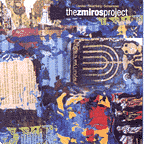 London, Sklamberg, Schwimmer / The Zmiros Project, 2002. Traditional Crossroads, 80702-4309-2, www.traditionalcrossroads.com
London, Sklamberg, Schwimmer / The Zmiros Project, 2002. Traditional Crossroads, 80702-4309-2, www.traditionalcrossroads.com
A couple of years ago, Frank London and Lorin Sklamberg and Uri Caine produced an album of hasidic-influenced music, "Nigunim." Here, London and Sklamberg, this time joined by keyboardist Rob Schwimmer, explore Sabbath hymns, "Zmiros." The CD was created in conjunction with a New York University book project, "Ain Sof: There is no end". In some ways, this is the other side of the Lerner/Wall album. Instead of setting new Yiddish poetry to involving music, London, Sklamberg, and Schwimmer have dived into the world of Sabbath hymn, rearranging, resetting, and sometimes, simply transmitting. The end result is an album of Jewish words that winds and weaves through our consciousness. As Jim Loeffler writes in the liner notes: "Throughout a long and complex history, Jews have constratly striven to interweave music and text in order to express the full dimension of their spiritual and national longings."
To set the context, the CD opens with two settings of the familiar Sabbath welcoming song, "Shalom Aleikhem," and then moves to a folky setting of a familiar melody to "Veshomru" ("and the children of Israel kept the Sabbath...."). They use a familiar melody again on "Eyliyohu hanovi," preceded as it is by a lovely piano introduction. The music on this CD is lovely--London's soaring, muted trumpet, Schwimmer's keyboard arpeggios, Sklamberg's warm tenor, all point the way towards exploring Jewish identity not by grabbing a few fragments to be preserved amongst other influences, but in diving more deeply into the meaning and longing of the Sabbath, as expressed in the Sabbath hymns. The intent to go more deeply, rather than mine for artifacts is also expressed strongly in Loeffler's scholarly (but very pleasantly readable) liner notes, discoursing on whence Sabbath zmiros, and on the specific zmiros. In truth, however, it took a while for me to read the notes, because the music was far more compelling than could be served without actively listening. London's long instrumental introduction to "Mizmor L'dovid", for instance, is simply marvellous--not so weighty as his recent Invocations, but no less pleasurable. Sklamberg's words and "ya boy boy"s are perfect. The contrast with the following, "Omar hashem leyakoyv," with the more spacy skat singing, and Schwimmer's theremin is considerable. Both, however, anchor the awareness that this music has mystical significance. Sabbath, after all, is a time of such significance that the 16th century Hasidim in Tzfat used to walk out of town singing, to greet the Sabbath bride. It was on the Sabbath that the male and female aspects of God came together; on Sabbath that exile and Israel were united as one.
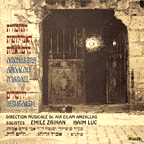 Orchestre Andalou D'Israel / Jerusalem. Magda MGD007, available in the US from Hatikvah Music, www.hatikvahmusic.com
Orchestre Andalou D'Israel / Jerusalem. Magda MGD007, available in the US from Hatikvah Music, www.hatikvahmusic.com
A recent talk given by a scholar of Turkish music at my synagogue emphasized what those of us who have listened to a wide variety of Jewish music already knew: Jewish music roots parallel those in every land in which Jews have lived. And, in particular, Jewish participation in the world of Arabic music, as well as the incorporation of Arab music into Jewish life, goes very deep. The Andalusian Orchestra of Israel is a powerful case in point. Several people have made a point of mentioning the group to me in recent months, and now that I have a disk to listen to, I understand why. To my ears, this is classical Arabic music, having more in common, say, with classic Oum Khultum (the nightingale of Egypt) albums, than with Ashkenazic cantorial music. Like those classic Oum Khultum sides, the music is characterized by masses of violins all playing the same notes, oud solos as well as the massed violins responding to the lined out, amazingly stretched out vocal pyrotechnics on the sung verses, and by a wonderful percussive accompaniment. Where this differs from those sides, of course, is that she never sang with Emil Zrihan or Haim Luc, the vocal soloists here, and she never sang piyutim, hymns dedicated to various rabbis. The medieval Hebrew is hard for me, with my half-forgotten secular, modern Hebrew to parse (so feel free to correct where my mistranslation loses the spirit of the piece: "God has commanded all turn to him / All the house of Israel in its entirety / pray and request / peace on Jerusalem...." What is also amazing, as I listen to Zrihan and Luc bring out this Anadalusian equivalent of the more familiar work of great Ashkenazic cantors, is how similar both are in the soulfulness and longing of the prayer.
This is truly amazing, expressive Jewish music, following a Jewish-Arab tradition going back to Andalus, the Golden Age of Arab Spain. From there, it migrated across to North Africa, and throughout the Arab world. What groups like the Andalusian Orchestra do is to remind us of how this was and is a part of Jewish culture, as well. What only a group as talented and deep as the Andalusian Orchestra do is make us long to hear more music like this, and to develop a hitherto unsuspected longing for different scales, different sounds, but in particular, these musicians and these singers. Nor can I claim to have known of this heritage ahead of the rest of American Jews. While I was quick to discover Oum Khultum, and even Fairuz and Walid al Atrache when I lived in Israel, the discovery that this is Jewish music as well, and that there are Jewish artists on that level is almost as new as this review. (I had heard Emil Zrihan years ago, and seen him give his all in several concerts, so I knew that there was something amazing out there. But this orchestra is even better than seeing him by himself with his own ensemble, incredible as that may sound to those who have, like me, gotten that far.)
As befits a recording of liturgical music, the pieces are longer than would be the case on a pop album. They are often medleys of various piyutim, strung together with call and response with the orchestra (and sometimes, with backing choir). Other than a lovely orchestral introduction piece, these pieces belong to the singers. This recording not only opens up new doors to amazing music, it opens the door to a culture that America's Jews of a primarily Ashkenazic background are just beginning to discover. Exciting times and culture are ahead.
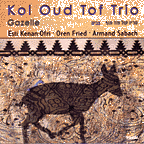 Kol Oud Tof Trio / Gazelle, 2002. Magda MGD037, available in the US from Hatikva Music, www.hatikvahmusic.com
Kol Oud Tof Trio / Gazelle, 2002. Magda MGD037, available in the US from Hatikva Music, www.hatikvahmusic.com
Most Jewish-Arabic music heard in this country, most commonly Israeli bands such as Habustan Avraham or the East-West Orchestra, or Davka, or Pharoah's Daughter, follows a model of sparse instrumentation, usually Oud and Percussion (and more, dependending on the group), and perhaps vocals. The literally named "Kol Oud Tof" (Voice Oud Percussion) Trio in Jerusalem strips the music down to its essentials. Led by the amazing voice of Esti Kenan-Ofri, the trio performs traditional Moroccan religious music, as well as songs from Jewish women's repertoire, Sephardic folksong, and classical Andalusian songs. The languages range from Haketia, the Ladino of Jews of northern Morocco, to Hebrew. The music is always soaring, always interesting. The words to some of the songs, such as "L'cha Dodi," are familiar, but the melodies are very different. In spareness and theme, songs such as "Tell my beloved" or "Sherifa" (about a Morrish Queen who chooses a Christian handmaiden who turns out to be her own long-lost sister), or the delightful "So Says the Bride" will often remind listeners of, say, the albums of the more folky Judith Cohen (who, not surprisingly, also spent time performing Moroccan Jewish music with Gerinaldo). To the casual or uninformed listener, this will sound like "Arabic Music," especially in the complex improvisational ornamentations of Kenan-Ofri's voice. The shock comes when text is recognized as Jewish, or when the words on some of the songs are recognized as Hebrew. It is also interesting to note that percussionist Oren Fried, here sounding entirely traditional, has also played with Israel's shock avant gardeist, Meira Asher, whose own pieces are grounded, in some ways, in this type of traditional musical storytelling and presentation). Although I personally prefer the heady strength of the orchestra behind, say, the Orchestre Andalous d'Israel, Kenan-Ofri's voice is a revelation, and the amazing oud and percussion support her well. This new release is a must for anyone interested in Jewish Moroccan music, or to Arabic music in general, or to anyone open to unfamiliar, beautiful, Jewish music traditions.
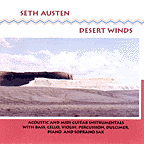 Seth Austen / Desert Winds, 1996. Sacred Cow Music, PO Box 555, Ashland, NH 03217, 603-968-3249
Seth Austen / Desert Winds, 1996. Sacred Cow Music, PO Box 555, Ashland, NH 03217, 603-968-3249
Instrumentalist Seth Austen is best known in Jewish music circles for his klezmer performances and teaching, as well as for his participation on the Jewish music mailing list. On this album, he sidesteps the question of traditional genre and performs a number of free-formish pieces, sometimes meandering, lovely guitar, as on "Clouds," sometimes more structured melodies, as on "Heat Wave," and sometimes, as in "The Computer is Down," just plain fun. This is the sort of music one listens to simply to enjoy the instrumental wandering. The interplay between midi and guitar, as well as sparse accompaniment by various side folks on instruments ranging from bodhran to cello to bells is intricate and well-done. All pieces are composed by Austen, except for "'Round Midnight," here performed by Austen with accompanying bass. For those who enjoy music from labels by Windham Hill, or who have enjoyed the intricate guitar work of John Fahey, this is an excellent, hard-to-find delight.
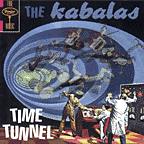 The Kabalas / Time Tunnel, 1999. Dionysus Records, PO Box 1975, Burbank, CA 91507. ID123379. www.kabalas.com
The Kabalas / Time Tunnel, 1999. Dionysus Records, PO Box 1975, Burbank, CA 91507. ID123379. www.kabalas.com
We rushed to review the first Kabalas albums with great pleasure. Then this one slipped through the cracks. And they haven't released a new album since. It is obviously our fault, and the world is poorer for our neglect. The Kabalas, here (as elsewhere) demonstrate a zany sense of humor, mastery of klezmer and polka and everything in between. The band is kind of, oh, a Jewish Brave Combo with stranger lyrics (but, sadly, perhaps less gifted vocally). They are the true inheritors of Mickey Katz and Spike Jones. With subjects ranging from "The Dybbuk" (a rather polkadish number) to "Photograph of Aunt Rachel Doing the Cha Cha at Cousin Ira's Bar Mitzvah (Circa 1963)" to wisdom as in "Do it on your own time", or instrumentals such as "Quiet Shtetl" (with echoes of "Grine Kusine", albeit with xylophone and sax, as well as traditional instrumentation) and "At the Rabbi's Table" turned into a horror movie soundtrack, the Kabalas represent something essential and fun. This sometimes is a problem: was their version of "Erev Ba" an uncharacteristic attempt to simply play a lovely song nicely, or satire? I lean towards the latter, probably because of the round. Still, if I have offended, or worse, if the lack of a review on the klezmershack of a delightful album--a Time Tunnel to a Jewish community differently funny from the one of today--has hindered the band in any way. I apologize. This album is still funny, now, though. And just as relevant, so don't be shy. Go visit the band's website and get caught up.

